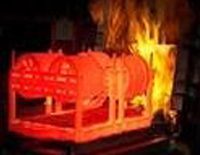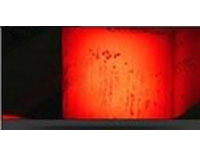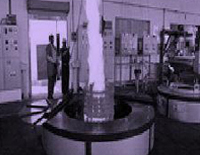Annealing
Solution Annealing, Isothermal, Spheroidized Annealing
Spheroidize Annealing :

- Spheroidize annealing is beneficial when subsequent machining and/or hardening is required (since the microstructure consists of rounded cementite particles in a ferrite matrix).
- The spheroidized condition is the true equilibrium state of the steel and is its softest condition.
- The spheroidized microstructure also ossesses good cold-forming characteristics.
- Generally, the larger the spheroids and the more distance between them, the greater the ability of the steel to be cold formed.
- The importance of prior condition in spheroidize nnealing applies to all steels regardless of carbon content, and the presence of coarse pearlite is ndesirable because of resistance to spheroidization
- Full Annealing - (Size - 1000 X 3000 mm)
Solution Annealing :


- Solution Annealing of stainless steel is a process which takes the carbides that have precipitated in the grain boundaries and dissolves then into the surrounding matrix.
- The austenitic stainless steel castings are typically solution annealed at temperatures more than 1040º C and rapidly cooled to prevent a repeat of carbide precipitation in the grain boundaries.
- Some alloys due to their low carbon content do not need a solution anneal due to carbide formation, but benefit from a solution anneal to achieve maximum corrosion resistance.
Full Annealing Service :

- A full anneal typically results in the second most ductile state a metal can assume for metal alloy.
- It creates a new uniform microstructure with good dynamic properties.
- To perform a full anneal on steel for example, steel is heated to 50°C above the austenic temperature and held for sufficient time to allow the material to fully form austenite or austenite-cementite grain structure.
- The material is then allowed to cool slowly so that the equilibrium microstructure is obtained.
- In some cases this means the material is allowed to air cool.
- In other cases the material is allowed to furnace cool.
- The details of the process depend on the type of metal and the precise alloy involved.
- In any case the result is a more ductile material but a lower yield strength and a lower tensile strength.
- This process is also called LP annealing for lamellar pearlite in the steel industry as opposed to a process anneal, which does not specify a microstructure and only has the goal of softening the material.
- Often the material to be machined is annealed, and then subject to further heat treatment to achieve the final desired properties.
If you have any query related our products ... We are available



